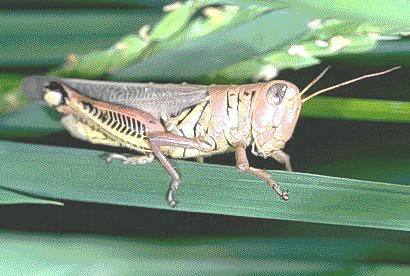PG2.7. Grasshopper Mark and Recapture

This investigation involves a method of estimating the population size of grasshoppers and other animals. This activity is conducted outside in the fall, in an open field that will remain undisturbed for 1-2 weeks. We capture grasshoppers and mark them in a way that will not injure them.
The marked grasshoppers from the first sample (M) are released where they were captured. A week or two later, a second sample from the same population is taken (p). Some individuals will be marked, or recaptured (m) from the first sampling, while others will be captured for the first time, and thus will be unmarked. The ratio of marked animals (m) to the total number of animals in the second sample (p) is assumed to be the same as the total number of marked animals (M) is to the total population size (P). Mathematically, m/p = M/P or P = (M x p) / m which can be used to estimate of the total population of grasshoppers.
Materials:
- 2 insect sweep nets
- Paint or nail polish
- 4 flags or stakes to mark sampling plot
- 1 large sheet Paper and pencil
- 1 large plastic container with lid
- Field guide to insects
- 1 metric tape measure (Or pace off the area)
Strategies for Investigation
- Mark off a grassy area that is 10m x 10m. Mark corners with flags.
- Two student collectors move through the site vigorously sweeping their nets through the vegetation. Students begin at opposite sides of the site to avoid driving grasshoppers out of the sampling area.
- Take the animals caught to the side of the sampling plot. Carefully open the net just enough to catch the grasshoppers one at a time. While one student holds a grasshopper, another puts a dot of nail polish or liquid paper on its thorax, being careful not to get the marking substance on the wings or the head. Put each grasshopper into the plastic container as it is marked. One student must keep a tally of how many grasshoppers are marked (M).
- Repeat steps 2 and 3 two more times.
- Release all grasshoppers into the center of the sampling plot.
- Return to the same plot in 1-2 weeks and repeat the sampling. This time you will capture some insects that are marked, which have been recaptured from the original sampling, and some individuals that are unmarked, or captured for the first time.
- Calculate the population size estimate using the equation P = (M x p)/m, where M = the total number of individuals marked in the first sample, m = number of marked individuals in the second sample (marked + unmarked), P = population size estimate ((M x p)/m).
Method of Evaluation
Write a paragraph describing how you felt about handling insects before and after you participated in this activity.
Write a “Today I learned… “ entry in your journal.
Write a paragraph explaining what you can learn about grasshoppers by doing the GMR that you can’t learn by dissecting them (and vice versa).
*(Adapted by Carolyn S. Nevin, co-author, from the 1993 Curriculum Guide of the Northeast Alabama Network of Environmental Educators)


